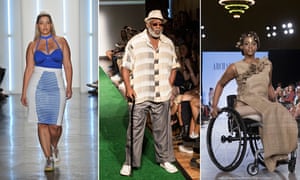The new trend in catwalk casting proves that people matter more than clothes

A model at the Chromat fashion show, an ‘ordinary dad’ at Josh ‘The Fat Jew’ Ostrovsky’s ‘dadbod’ show, and model Leslie Irby at the FTL Moda show – all at New York fashion week, September 2015. Photographs: Fernando Leon/Getty Images; Nicky Digital/Andrew Kelly/Corbis
Haters, form an orderly queue. I probably shouldn’t say this out loud, because it’s not as if you lot don’t have enough anti-fashion ammunition anyway, but I’m going to. This is the 15th year I’ve been going to fashion shows, and for much of that time I barely noticed how thin or how young the models were. I know, I know. I’m a bad person.
I watched shows and came out thinking and talking about the zip placement or the music or the front-row scene, and did you notice such-and-such must have had a falling out with so-and-so because they usually sit together, and only later discovered that the show had hit the headlines because one of the “girls” was generally felt to be shockingly skinny, or was 13 years old. Sometimes this felt like a deliberate missing of the point, because you wouldn’t find a footballer’s new haircut on the back page of a newspaper where the match report would be. But it turns out it was me who was missing the point. I was looking so hard at the clothes that I didn’t see the people in them.
But now I’m looking. Because, after the supermodel and the size-zero debate, we are entering a new era: the age of the “nodel”. Nodel – or non-model – is the breakout buzzword from New York fashion week, where designer Mike Eckhaus of Eckhaus Latta told Vogue that their diverse casting was about a “combination of working with models and ‘nodels’ – friends and peers. I think it creates a more dynamic texture and quality to the clothing.”
At this season’s fashion shows, which have moved from New York and are now in London, there is still an absurd proportion of girls of extreme skinniness – see thedebate over Victoria Beckham’s show – but there are also examples of diversity that the public want and expect to see on the catwalk. Chromat designer Becca McCharen’s New York catwalk showcased her hot bodycon dresses on size 16 models as well as size 8. Black models are still under-represented, but emerging consciousness of this at least means that all-white lineups look increasingly anomalous when they do happen. Model Leslie Irby, who uses a wheelchair, took part in the FTL Moda show in New York. Josh ‘The Fat Jew’ Ostrovsky’s ‘dadbod’ show – itself an expression of how the catwalk aesthetic is moving from uniformity to the unexpected – was peopled by “ordinary dads”. Paralympian Stefanie Reid modelled for Lenie Boya in London this weekend.
People matter, not clothes. And it’s models who populate fashion. On catwalks and billboards, models are the people you see, so how the models look matters. Fashion has been democratised and where once trends travelled with painstaking slowness and ludicrous secrecy from catwalk to ground level, fashion now happens everywhere. You can watch a fashion week show live on the internet; more and more often brands are making like Burberry and Versace and opening up retail the moment a show ends. Fashion used to be about the designers as demigods; now it is about the people who buy it and how they want to wear it.Models wear the clothes, and therefore, at some level, represent the consumer. Now that the consumer matters more, the model also matters more.
Someone once said that fashion is the expression of female desire. There is something in this and I suspect it is connected with how any fashion that isn’t just pretty dresses is greeted with hostility and derision by much of the establishment. Without getting into one of fashion’s endless dog-ate-my-homework excuses (“It’s not that we want thin models, it’s just that we only make the samples in a size minus two, so then you see we have to use thin models!”), it is true that catwalks do not set the ideals or define the debates or create the dysmorphias. They reflect them. The unspoken philosophy behind the old-school army of wan, pale, teenage models was that people are – or should be, or should try to be – all the same. Which is nonsense. Whereas the nodel, though it sounds like a nonsense word, makes perfect sense.
No comments:
Post a Comment